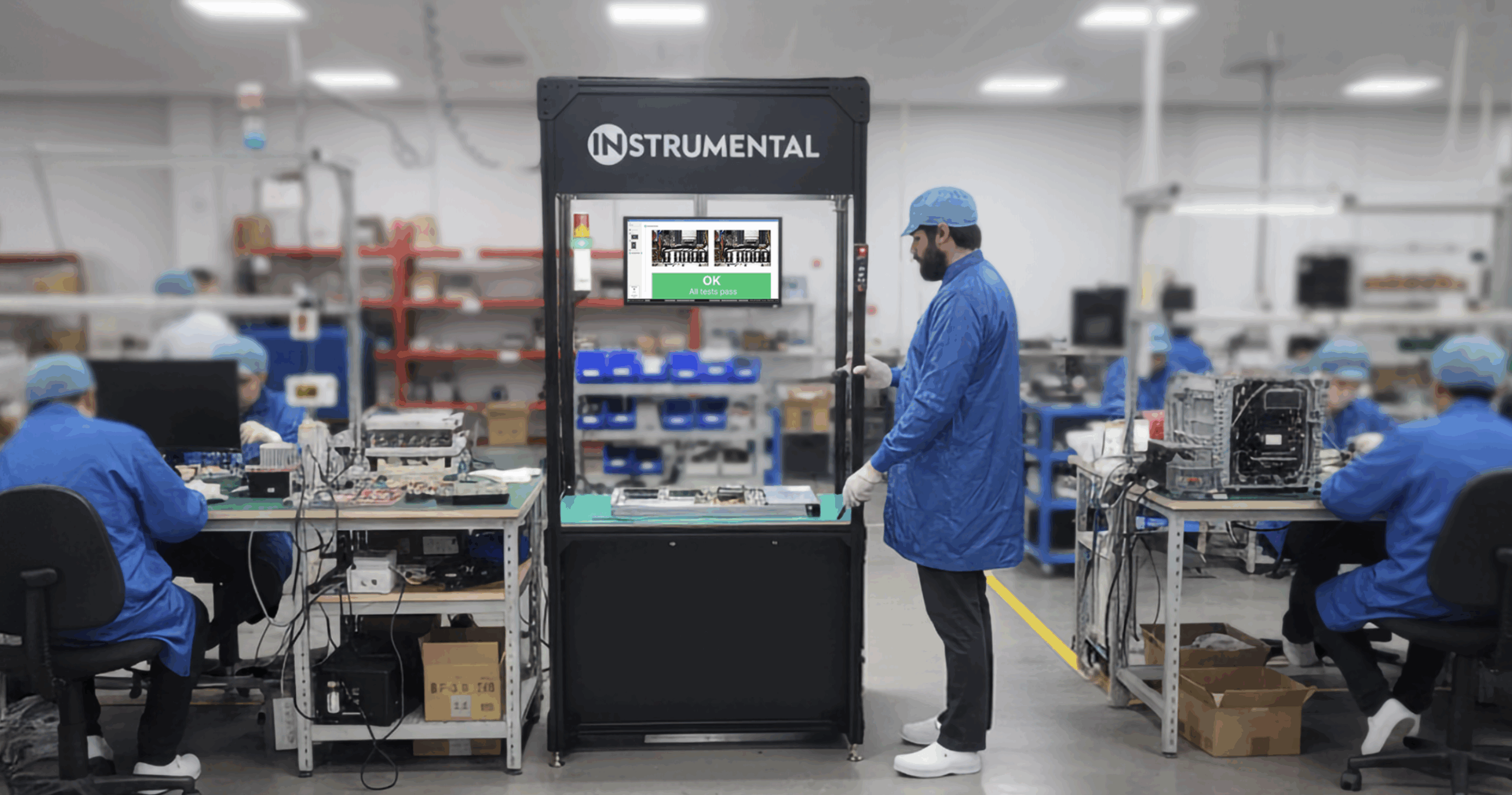Amazon hardware has come a long way since the release of the first Kindle in 2007. Since that retro funky e-reader changed the publishing industry, Amazon has expanded into new categories including the Fire line of tablets, the ill-fated FirePhone and ever more variations of Echo devices that feature its digital assistant, Alexa.
It’s clear that Alexa is a big part of their vision for the future. From wall clocks and microwaves to their newest home robot, Astro, Amazon’s product teams are continuously searching for the perfect way to incorporate the voice assistant in the home. That’s why for our first in-person teardown event at Instrumental headquarters in Palo Alto, we decided to tear down the Amazon Echo Show 10.

Audience members explore Instrumental’s Teardown Playground, which displayed products featured on previous teardowns.
Due to an ill-timed vacation, this was my first Instrumental teardown as a member of the audience but I felt part of it all the same. It was fun to tour the Teardown Playground — where our previously torn down products were on display for folks as they moved between the products and the delicious empanadas, beer and other refreshments. With my Teardown Bingo card at the ready, I enjoyed watching Team Teardown — Tobias Harrison-Noonan, Will Greenbaum and Molly McShane — take us through the latest Echo Show.

The Amazon Echo Show 10 – Image courtesy of Amazon.com
Overview of the Amazon Echo
First released in 2014, the Amazon Echo was a bold experiment that launched a whole new category of product: the standalone virtual assistant. The experience has evolved over the years to include a display component on the Echo Show devices. The newest Echo Show 10 actually swivels and follows you around, tracking you through both the on-board camera and far-field voice interactions.
Along with a 10-inch touchscreen, it also features a 13 megapixel camera with a physical shutter slide to preemptively address the privacy concerns of a smart device visually tracking its user. This is all in addition to some pretty hefty audio components with a large subwoofer and two tweeters.
Tearing down the Amazon Echo Show 10
Will started the teardown by popping off the upper speaker mesh which revealed the subwoofer and some green screws at the top. Throughout the teardown, the team found many clusters of colored screws. The Amazon engineers likely decided to color-code the screws of different subassemblies to reduce mixups on the line.
While Will was busy removing screws, Tobias helped guide the discussion fielding questions from the live and remote audiences. After polling the audience on what they wanted to see first — display, speakers, or motor assembly — (motor assembly for the win), a question came up: how was the product tested on the factory line while being assembled?
Without any obvious connectors, the audience and the team searched for possible solutions. A rather specific note from an online viewer pointed to a set of contact points on the hinge that were exposed when the display was tilted just so. Even with these contacts, it looks like a custom connector was required to physically connect to the pins, which also had some locating holes to guide the mystery connector into place.

Contact Pins for testing or communication hidden near the display
Will peeled up the rubber foot on the bottom and removed some tight screws with a power drill because they were on very tight. He was then able to slide off the main housing and uncovered the main power board. Because the display blocked the best view of the circuitry, Molly shared some photos on the Instrumental platform to take a closer look while Will continued to unscrew more parts.
Molly highlighted an interesting vertical ZIF connector for one of the main I/O FPCs, something few people on stage or in the audience had ever used before. With several tall capacitors secured by black epoxy, she speculated that perhaps there wasn’t a connector that could allow the cable to fit without going around those components.
In an interesting comparison, Molly also pulled up images from the Sonos One speaker we took apart in an earlier episode to compare the size and density of the power board components and the glues used to hold the large caps in place. Will mentioned one significant difference between the two is that the Echo Show came with a wall adapter while the Sonos tapped directly into the AC power coming from the wall, suggesting there might be different needs based on what type of power the board was handling.
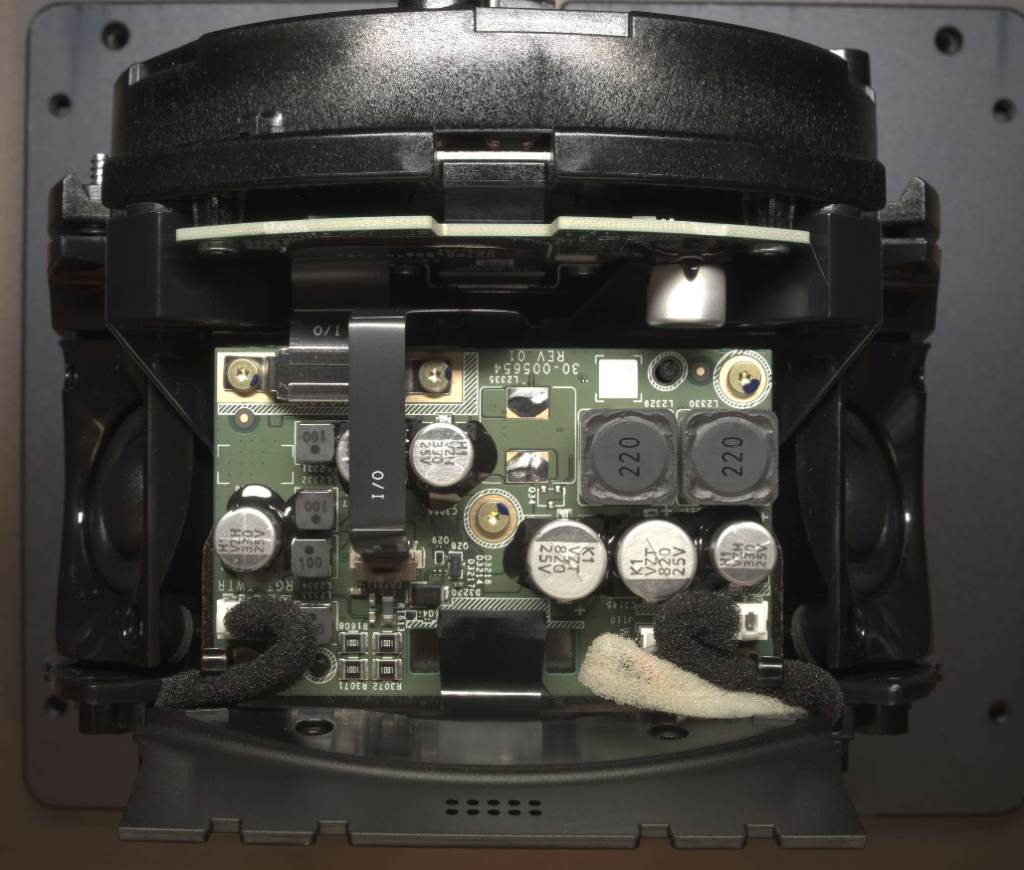
Echo Show 10 power management board
Amazon Echo Show motor assembly
When we revisited Will, he had made significant progress taking apart the main motor assembly, separating out a number of metal components including some cowlings, bearings and a snap ring. Once the two halves of the motor assembly were separated, he revealed a custom rotor with 27 windings and stator with 30 permanent magnets.
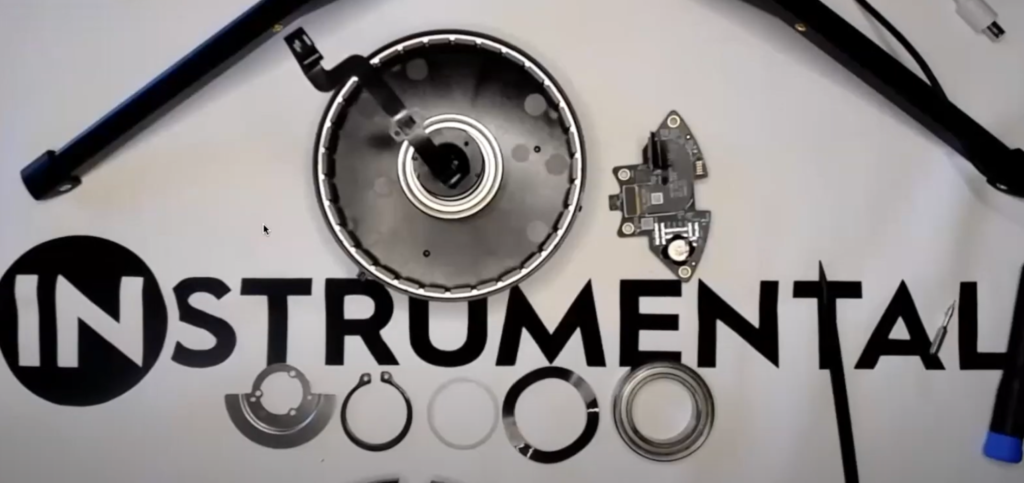
Major components of the Echo Show 10 motor assembly
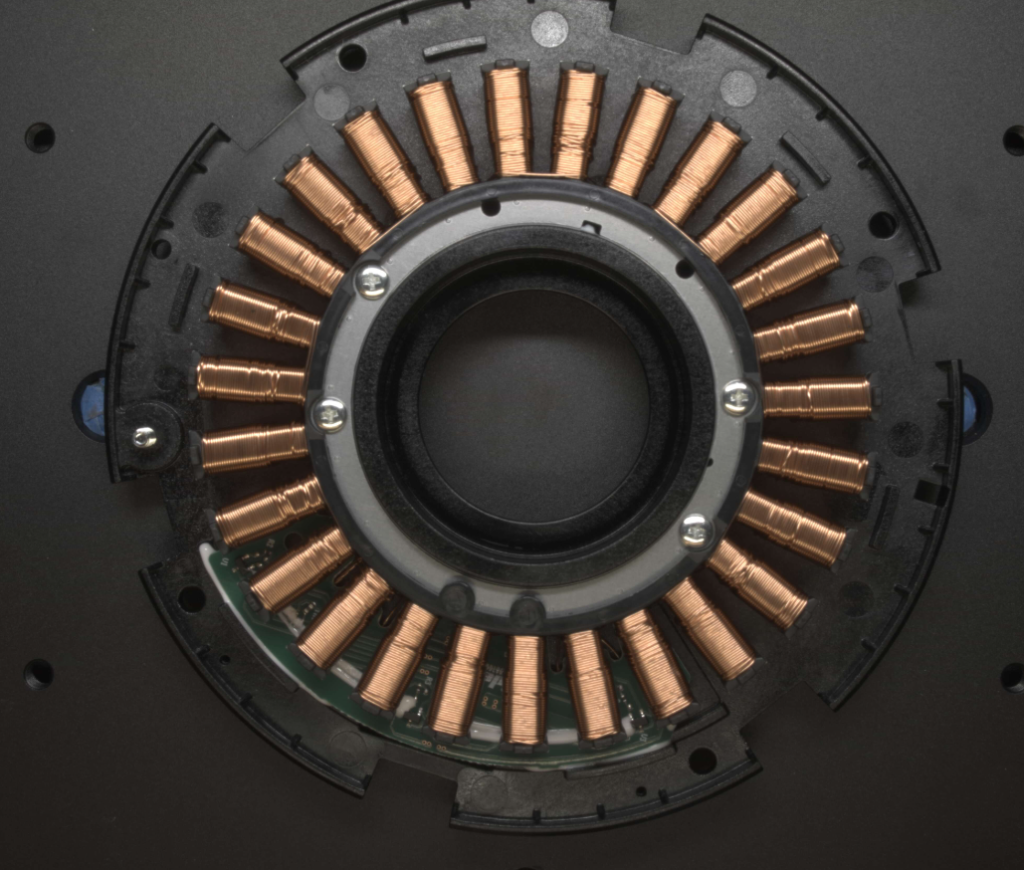
Custom motor windings on the rotor of the Echo Show 10
Will suspected that the custom motor design allows the product to not only swivel precisely, but also hold its position within a narrow range while the display is touched. Because of that swiveling action, another interesting feature of the product is the long and coiled-up power FPC that connects the simple barrel jack at the base of the product to the main power and logic boards.
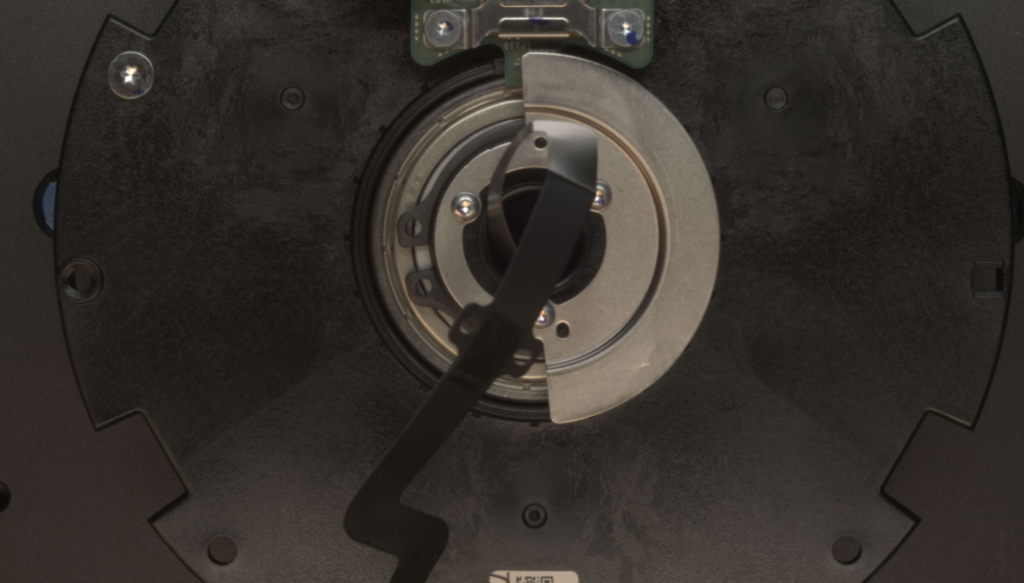
Long custom flex cable to connect the power and motor signals to the main PCBA
The Echo Show 10 needs to be able to transmit power and signals while rotating which led to the FPC design that can accommodate the maximum twist of the display over the lifetime of the product. If the product is meant to last 5 years and might swivel 10 times a day, that’s over 18,000 rotations! This is not unlike a car’s steering wheel and several members of the audience mentioned their experience with cable bundles or twisted FPCs for much the same reason and indicated how difficult it can be to get the design to be reliable.
Before moving on to the display, there was a great discussion about Amazon’s inclusion of a small RFID tag. While some speculated that it might just be a serial number replacement, Tobias and some members of the audience suggested it might be a way for Amazon’s logistics operation to track or personalize devices.

RFID Chip at the base of the Echo Show 10
Display/Tablet of the Amazon Echo Show
Will opened up the back of the display using an iFixit tool to pry off the plastic cover, and then used the drill to remove the hefty hinge. Molly was able to confirm that the metal midframe revealed underneath was cast with an aluminum alloy after zooming into a label marking the material as A360R.
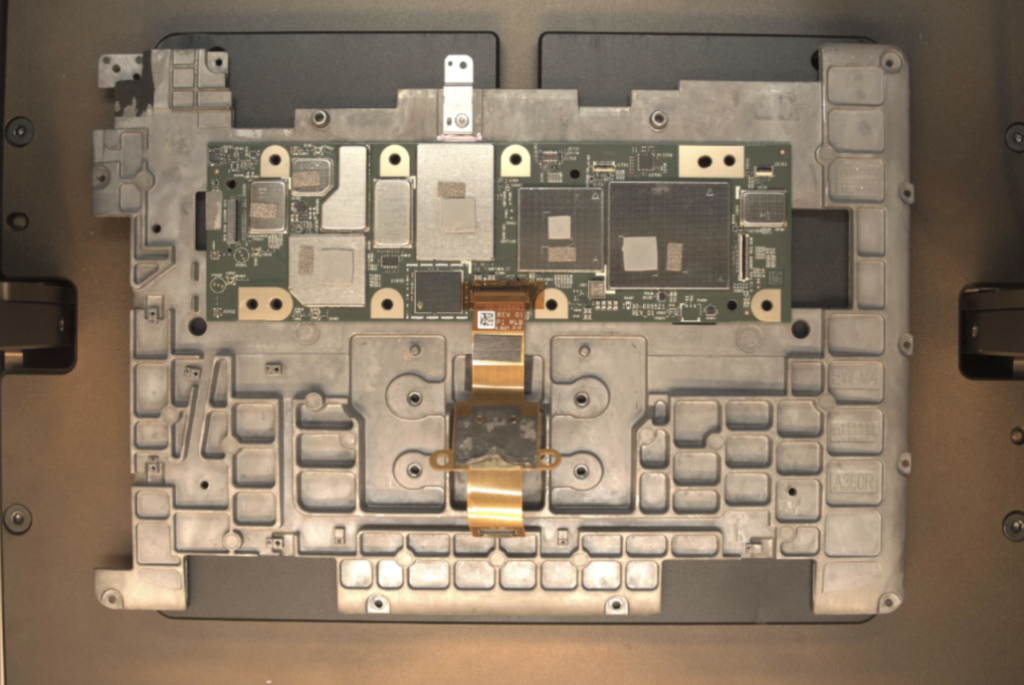
Inside the display/tablet of the Echo Show 10
With a traditional tablet, a midframe like this might be more likely to be made of magnesium to reduce weight. Also, the space that Amazon allocated for the ribs would typically have been taken up by a large battery which allows them to create a rigid body to handle all those touch events.
Molly panned around the midframe revealing multiple flex cables and antennas that were assembled out to various edges around the product. There are three main sets of antenna connections on the left side of the image corresponding to bluetooth, wifi, and a mystery antenna – possibly a proprietary Amazon Sidewalk antenna. But interestingly, Molly noticed space for a fourth antenna that was not populated. It also had a routing path back to the board and mounting points along the way suggesting either a different SKU or a last minute removal to save some cost.
The team also showed how Amazon engineers used both thermal paste and thermal pad solutions over the main board to more places along the large metal midframe with a great discussion on the pros and cons of both.
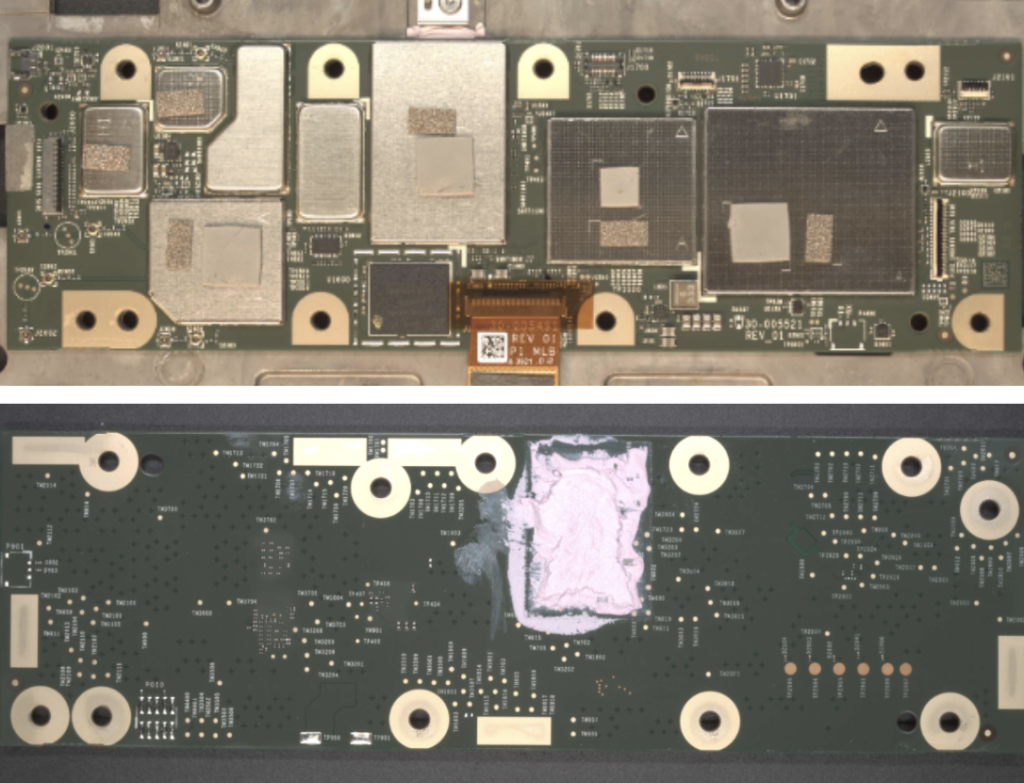
Top and bottom sides of the PCBA with thermal pads and thermal paste visible
Wrap-up
The Echo Show 10’s slim tablet display rotating around a powerful stereo speaker system with a built in subwoofer made it clear that a deep knowledge of mechanical and electrical design was required to pull this off. Analyzing the design choices in person with our knowledgeable audience made this teardown that much more interesting.
If you would like to attend an event like this in the future, let us know. In the meantime, is there another product you’d like to see us open up?
For access to the teardown library with the Echo Show 10 and all of the other devices from the Change Notice Unsnapped series, contact us at communications@instrumental.com.
Chris Li is a former Amazon Product Design Engineering Manager and teardown lead for Instrumental. He brought multiple generations of the Kindle to market and advised on the first Echo and Fire TV products. He also worked as the VP of Product Design at the healthtech startup, PillDrill, which shipped an award-winning medication tracking system. He is now a Mechanical Engineer at Agtonomy, an autonomous tractor startup.
Related Topics



